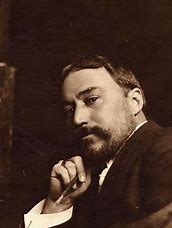
Eanger Irving Couse was born in Saginaw, Michigan. His lifelong pursuit of painting Native Americans was kindled by the beauty and tranquility of the local Chippewa and Ojibwa cultures. Couse chose a career in art at an early age, studying at the Chicago Art Institute, the National Academy of Design in New York, and, as was the dream of many young artists of the time, at the Académie Julian in Paris. The training he received in Europe, particularly under Adolphe Bouguereau and Tony Robert-Fleury, influenced the measured studio style he practiced for the rest of his life.
In Paris, Couse married a fellow artist whose family ranch in Washington State provided him with access to a number of Indian tribes. Lyrical portraits of the Klikitat, Yakima, and Umatilla, painted in the Barbizon style, were his first attempts at this truly American subject. His historical narratives of the West brought him great acclaim at the Paris Salon exhibitions.
Finding French peasant scenes and European landscapes more saleable, Couse returned to a successful career in France. However, upon the advice of fellow artists, Joseph Henry Sharp and Ernest Blumenschein, Couse made his first visit to Taos in 1902. Though Couse maintained a studio in Manhattan during the winter months until 1928, Taos was his inspiration and became his permanent home.
Couse was elected to full membership in the National Academy of Design in 1911. His paintings are represented in numerous museums and private collections including the Detroit Institute of Art, the Metropolitan Museum and the National Portrait Gallery of the Smithsonian Institution. Through the many paintings created for the railroad, his painting received national exposure and brought recognition to Taos. Couse created images that were highly influential in changing the public's perception of the West and many are regarded as poetic renderings of a vanished time.